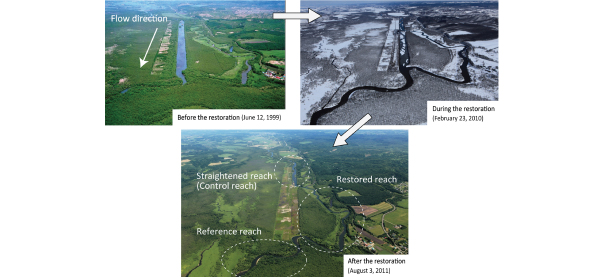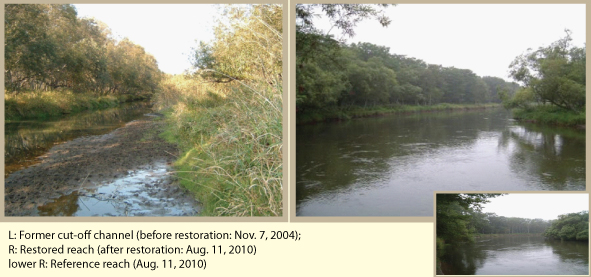Evaluating Meander Restoration —Case of the Kushiro River—
Research Press Release | May 26, 2014
-
 Figure 1. River meander restoration project carried out in the Kushiro Wetlands The river water began to flow again (top right) through the old river course separated from the river by straightening (top left); refilling part of the straightened section with sediment; restoring the meandering river (below).
Figure 1. River meander restoration project carried out in the Kushiro Wetlands The river water began to flow again (top right) through the old river course separated from the river by straightening (top left); refilling part of the straightened section with sediment; restoring the meandering river (below). -
 Figure 2. River scenery in a meander restoration section and in a natural section The scenery after meander restoration (R) is similar to that in a natural section which still remains on the original meandering river (lower R), showing that this project successfully restored scenery similar to that in natural condition.
Figure 2. River scenery in a meander restoration section and in a natural section The scenery after meander restoration (R) is similar to that in a natural section which still remains on the original meandering river (lower R), showing that this project successfully restored scenery similar to that in natural condition.
| Press Release | ||
|---|---|---|
| Key Points | ・The effectiveness of the first “River Meander Restoration Project” in Asia, which was conducted on the Kushiro River that flows through the Kushiro Wetlands, has been scientifically evaluated.
・Meander restoration not only restored the natural scenery, it also restored the species diversity of the floodplain plants and aquatic organisms on the river and in the wetlands. ・These results are attributable to the complexity of the river shape and increasing flooding over the surrounding wetlands. ・The meander restoration shows that it will be effective as a future method of restoring river and wetland environments. |
|
| Overview | Among many rivers flowing through industrialized countries, formerly “meandering rivers” have been transformed into “straight rivers” in recent years for flood control and development of the surrounding land. The progress of this straightening has not only created monotonous river topography, but by destroying links between rivers and surrounding flood plains, it has caused the decline of biodiversity in many rivers and wetlands, requiring effective restoration methods. In response to such circumstances, from February 2007 until March 2011 a river meander restoration project was launched on the Kushiro River that flows through the Kushiro Wetlands—the largest wetlands in Japan and also designated under the Ramsar Convention—to achieve the following four objectives: (1) to restore the habitat for fish and aquatic insects, (2) to restore floodplain vegetation by increasing flooding frequency, (3) to prevent runoff of nutrients, sediment and fertilizers to the downstream wetland areas, and (4) to restore the scenery of the river to near natural conditions.
The purpose of this research was to verify scientifically whether or not the above objectives were achieved by the meander restoration project. This study was conducted before and after the project and was based on the monitoring results of biodiversity and the physical environment, as well as through a field survey. The results have clarified that all the objectives were largely achieved and that meander restoration is an effective method to restore river and wetland ecosystems. This research was conducted with the cooperation of the Hokkaido Regional Development Bureau and with a subsidy to cover the costs of research, and was reported in the journal, Restoration Ecology (Electronic version) on May 14. |
|
| Inquiries |
Futoshi Nakamura, Professor, Research Faculty of Agriculture, Hokkaido University TEL: +81-11-706-2510 FAX: +81-11-706-3842 E-mail: nakaf@for.agr.hokudai.ac.jp |
|
|
Japanese Link |
川の蛇行復元を評価する- 釧路川の事例 – | |
| Publications | Restoration Ecology (2014.5.14) | |
